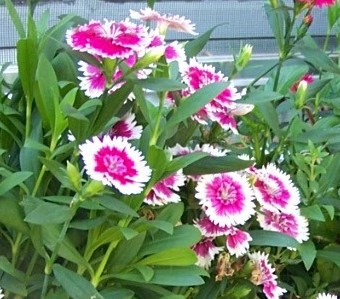|
Gardens Ablaze |
||
|
|
Reader's Questions
- Dianthus (Sweet William)
|
|
Site Map
Home |
 Question: I planted Sweet William
Dianthus in Spring of '07 and it bloomed for the first time this year. I
know that it is a biennial; does this mean that it won't come back next
year? I'm not sure if "biennial" means a plant's life is finished after
the year it blooms. (I'm in zone 5). Question: I planted Sweet William
Dianthus in Spring of '07 and it bloomed for the first time this year. I
know that it is a biennial; does this mean that it won't come back next
year? I'm not sure if "biennial" means a plant's life is finished after
the year it blooms. (I'm in zone 5).Answer: Theoretically, yes, as a biennial, the plant should die after flowering like it's supposed to. But is that what is really going to happen? Maybe and maybe not. I have been growing and watching this plant for years, and I still don't understand fully what makes it decide to finally die out. The longest-lived Dianthus I have recorded in my personal experience is about 3 years. I have watched it closely under controlled conditions in containers, and I have yet to see it self-seed, so it appears that it was the same plant throughout the 3 years. It does spread quite a bit and maybe its inner clock considers the newer portions new plants, thus explaining its longevity. Having said that, if your plant does make it into next year, it will be a nice clump indeed, but be aware that even though it might make it 2 and even 3 years, eventually it's going to die out and it will do so rather suddenly. Dianthus is one of my top 10 favorite garden plants because it is just so darn useful. Containers, window boxes, flowering ground cover, filler in the perennial bed - the list just goes on and on. Whatever triggers decline in this plant seems to happen all at once, in my experience - so either you have healthy plants everywhere or you have no plants at all. Because of this, I have implemented a policy of taking stem cuttings in mid to late summer of the healthiest and prettiest selections in my garden and rooting them in containers (I use flats that came with other plant purchases), and then transplanting them where I want them 6 weeks or so before the first frost so they will get acclimated before winter. When spring comes, they will leap out of hibernation and flower well into the summer (if not all summer), thus avoiding the wait for flowering that you have to endure when starting from seed. If some of the older plants survive another year, then good, but since there is no apparent rigid cycle that I can find, and not having Dianthus around is not an option I care to entertain, this is a good middle ground that absolutely works every time. Hope this helps and good luck!
Custom Search
|
|
|
Gardens Ablaze |
||